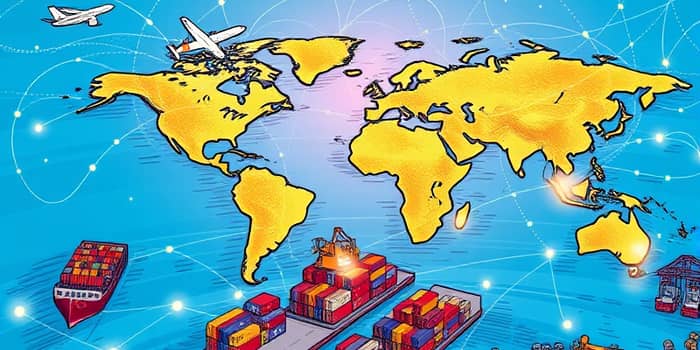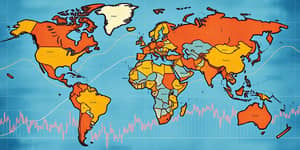In 2025, the landscape of global trade has undergone remarkable transformations. From surging imports in developed economies to the unprecedented rise of digital marketplaces, the currents of international commerce are changing direction. This comprehensive analysis dives into the latest data, geopolitical forces, and technological shifts, providing both context and actionable insights for businesses, policymakers, and observers alike.
Data Deep Dive: Trade by the Numbers
The first half of 2025 saw global trade expanded by $300 billion, representing 1.5% growth in Q1 and an anticipated 2% in Q2. While trade volumes crept up by just 1%, much of the value increase stemmed from higher commodity prices.
Trade in services proved resilient, registering a 9% rise over the past four quarters—services remain the main driver of growth. However, stark regional disparities emerged:
- Developed economies outpaced developing ones, reversing a trend that favored the Global South.
- The United States saw a 14% surge in imports, driven by consumer demand and inventory restocking.
- The European Union’s exports jumped 6%, led by pharmaceuticals, medical supplies, and high-value manufactured goods.
- Developing countries’ imports declined by 2%, with South-South trade largely stagnant.
- African economies proved the notable exception, posting a 5% export gain and 16% growth in intraregional trade.
To illustrate these contrasts more clearly, consider the following summary:
Geopolitics and Policy Uncertainty
The economic backdrop for trade remains challenging. Global growth is forecast at just 2.3% for 2025, weighed down by heightened policy uncertainty and rising trade barriers. New tariffs and sanctions have introduced costs akin to de facto taxes on cross-border exchanges, especially harming emerging markets.
Major flashpoints include ongoing US-China tensions, potential EU–China regulatory disputes, and spillovers from the Russia-Ukraine conflict. Each episode risks disrupting established supply chains, pushing firms to reassess sourcing and manufacturing locations.
Case in point: the US merchandise deficit narrowed to $60.2 billion in June, down 16% from May, as imports cooled post-tariff announcements. Yet, imports remain elevated at $337.5 billion, reflecting strong domestic demand and anticipation of further restrictions.
Digital Transformation and Market Concentration
The digital revolution in commerce is accelerating. The top five digital multinationals now command 48% of global digital sales, up from 21% in 2017. Such industry consolidation concentrates power among cloud, AI, and e-commerce giants.
Generative AI partnerships—like Microsoft with OpenAI and Google with emerging AI startups—are driving new efficiencies in logistics, predictive analytics, and customer engagement. Yet this concentration also raises competition concerns. From 2020 to mid-2025, there were 153 global competition interventions, compared to just 14 between 2017 and 2020. Enforcement remains uneven, with Africa and Latin America lagging.
Winners, Losers, and Emerging Inequalities
Not all regions benefit equally from these shifts. Developed economies have rebounded faster, while many developing nations face setbacks in value chains and trade growth. The gap is widening:
- Widening trade imbalances—the US deficit remains large, while China and the EU post surpluses.
- Africa’s export gains reflect growing regional integration and demand for commodities.
- South America and parts of Asia struggle with supply chain disruptions and policy volatility.
These disparities underscore the need for targeted policies to support developing economies, from infrastructure investment to digital skills training.
Persistent Frictions and Future Headwinds
Supply chain resilience remains a persistent challenge. Logistics costs are elevated due to congestion at major ports, rising freight rates, and secondary effects of sanctions. Firms are diversifying suppliers and nearshoring where possible, but costs remain sticky.
Geopolitical fragmentation—manifested in competing trade blocs and regulatory regimes—threatens to complicate cross-border commerce further. Yet there is a countervailing call for unity. Institutions like UNCTAD emphasize the importance of coordinated global action on competition law, digital infrastructure, and climate-aligned trade policies.
Conclusion and Outlook
As the latter half of 2025 unfolds, global trade faces a complex mix of opportunities and risks. While digital transformation and service-led growth offer new avenues, geopolitical tensions and policy uncertainty loom large.
For businesses, the path forward involves diversifying supply chains, investing in digital capabilities, and engaging proactively with policymakers. For governments and multilateral bodies, the priorities are clear:
- Strengthen enforcement of competition and digital regulations
- Invest in cross-border digital infrastructure and skills development
- Foster multilateral cooperation to reduce policy volatility and trade barriers
Ultimately, navigating the shifting tides of international commerce will demand resilience, innovation, and collaboration. Only through such collective effort can the global community ensure that trade remains an engine of sustainable growth and shared prosperity.
References
- https://unctad.org/publication/global-trade-update-july-2025-global-trade-endures-policy-changes-and-geoeconomic-risks
- https://unctad.org/news/global-trade-grew-300-billion-first-half-2025-led-us-imports-and-eu-exports
- https://www.oecd.org/en/data/insights/statistical-releases/2025/05/international-trade-statistics-trends-in-first-quarter-2025.html
- https://www.bea.gov/news/2025/us-international-trade-goods-and-services-june-2025
- https://www.worldbank.org/en/publication/global-economic-prospects
- https://unctad.org/publication/global-trade-update-september-2025-trade-policy-uncertainty-looms-over-global-markets
- https://unctad.org/news/uncertainty-new-tariff-costing-global-trade-and-hurting-developing-economies
- https://www.oecd.org/en/data/insights/statistical-releases/2025/08/international-trade-statistics-trends-in-second-quarter-2025.html










